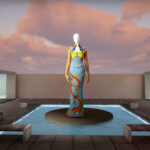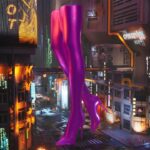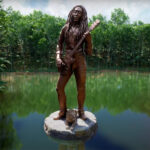Embark on a journey into the digital realm as the Fashion Art Institute, in collaboration with Exedos proudly presents an unprecedented Metaverse Experience – a fusion of fine art, virtual reality, and haute couture. The showcase, aptly titled “Fashion Art in the Metaverse,” unveils a captivating experience where fashion and art come to life in the digital realm with a collection of exquisite hand painted dresses, pushing the boundaries of traditional exhibitions.
This groundbreaking exhibition redefines the intersection of art and technology, inviting audiences to immerse themselves in a visually stunning and innovative fusion of fashion and art. Each dress within the collection has been meticulously crafted by renowned fashion designer Manuel Fernandez, and brought to life in collaboration with leading artists form Spain and around the world.
To create the experience, each piece in the collection was scanned and digitally recreated by Exedos in fully immersive 3D at the highest quality, and then placed in a virtual environment. The project embraces the limitless possibilities of the metaverse and seamlessly weaves together the worlds of art and fashion, offering a unique and enchanting perspective on the intersection of these dynamic realms.
People who experience “Fashion Art in the Metaverse” will have the opportunity to explore the digital gallery space, interact with the sculptures, enjoy the many virtual dresses and high quality artwork. The immersive experience promises to be a celebration of creativity, craftsmanship, and the boundless potential of digital expression.
Manuel Fernández, the visionary behind the project, expressed enthusiasm about the intersection of art and the metaverse, stating, “This project is a testament to the power of collaboration between different artistic disciplines. By bringing together fashion and art in the metaverse, we open up new avenues for creative expression and challenge the traditional boundaries of art.”
You can already view top pieces from the collection at the Fashion Art channel at Soulbank, and the complete experience is set to debut in May 2024. The final, immersive experience will be accessible on mobile devices, PC’s & Macs, and on major virtual reality platforms, offering a global audience the chance to witness this groundbreaking fusion of art and technology.
About Fashion Art Institute:
The Fashion Art Institute is a project born with the aim of analyzing and promoting cultural interaction, the crossing of references between plastic artists and fashion design from a strong commitment to sustainability, technology and social commitment .
www.fashionartinstitute.org
About Manuel Fernández:
Manuel Fernández has been a force of power in the world of fashion since 1983. His stance towards creation has been avant-garde, with touches of idealism. With a cosmopolitan attitude, he has always opted for internationalization of his design, and attended the New York Fashion Week for years. His designs are bold, daring, sensual, elegant and with a touch of humor.
www.manuelfernandez.com
About Exedos:
Exedos is a cutting-edge production company that is pioneering the fusion of technology and creativity to bring immersive experiences to life. With a focus on pushing the boundaries of traditional storytelling using state-of-the-art virtual reality technologies to transport audiences into captivating digital realms.
www.exedos.com





